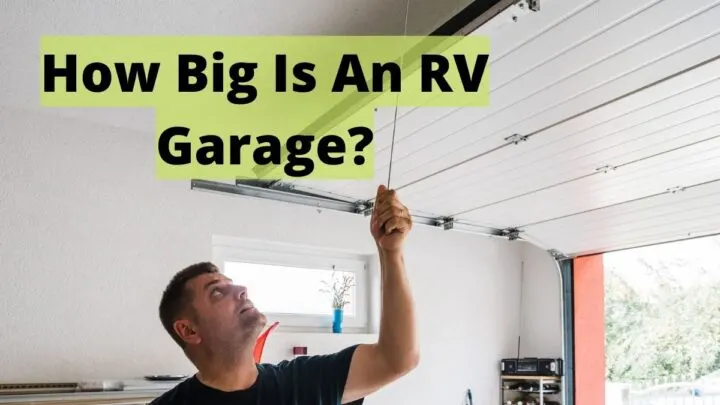An RV is going to be a significant investment, so it pays to make sure it’s protected. People who want to build an RV garage need to know just how big they are.
If the area you live in receives rainfall or snow, you will need to make sure that your RV is protected.
This is where an RV garage comes in and can keep your motorhome safe from the elements when it’s parked.
Most RV garages are 30 x 40 feet, which can protect most medium-sized RVs from harsh weather. The size of RV garages are determined by clearance height, along with the width and length of the RV.
This is why you should make sure to measure the RV carefully and include the side mirrors.
We have asked many RV owners who have built garages for their vehicles and have shared that information here for all those first-time RV owners looking to protect their investment.
How Big is an RV Garage?
Building an RV garage demands meticulous attention to detail since a low-quality construction can easily tip over by severe winds.
This is why attaching the RV garage to concrete flooring is always a good idea. To support the basic garage building or carport construction on all sides, secure it to the flooring with sufficient bolts or metal fasteners.
It’s alright to construct the garage out of lightweight metal or plywood, but you should use angle-iron and stainless steel screws or bolts at all joints and seams.
Simply fastening a structure in place is too dangerous because the wind may readily flow beneath a tall RV roof.
Choose a Design
How would your ideal RV garage or storage space look? Do you want a spacious detached garage to store your RV and maybe some other items that need a place near your home?
Do you wish to extend an existing garage with a larger bay? It will be easier to get started if you write down or communicate what you want with a custom garage builder.

Choosing the Right Size
With its unique cab-over bed, a Class C Motorhome is around 10 feet tall on average and may be anywhere from 21 to 35 feet long.
This RV usually necessitates a garage with a clearance height of at least 14 feet and a length of 40 to 45 feet.
A Class B Camper Van is eight feet tall on average and may be anywhere between 16 and 21 feet long. This RV usually necessitates a garage with a clearance height of at least 12 feet and a length of 25 to 30 feet.
A Class A Motorhome is the largest and most luxurious of all RVs, standing 10 feet tall and ranging in length from 21 to 40 feet.
This type of RV requires a garage with a clearance height of 14 feet and a length of 50 feet, depending on the amount of extra storage you want.
Most RVs are between 8 and 12 feet wide, and at least 10 feet is needed to drive the vehicle inside the garage comfortably.
Consider the width of your RV and the space required to open the vehicle’s doors when determining the width of your RV garage.
If you have only a little amount of space to work with, the goal is to strike a balance between a large enough size to fit your present RV and enough area to expand if you decide to upgrade.
The smaller motor home may be sufficient for the time being, but after you begin to appreciate the benefits of a movable home, upgrading to a bigger luxury model may be a possibility in the future and is something you should definitely consider when building an RV garage.
How Big are You Allowed to Build?
It’s a good idea to determine how much a design will cost and if it will be legally permitted to be built on your land now that you have a clear picture of what you want and know if it will be achievable after speaking with a specialist.
Get a detailed estimate of the project cost from a custom garage builder and take it home to evaluate whether it fits into your budget.
Make sure to add a little more to this fee in case of an emergency or something else unforeseen happening.
You should also verify with your local zoning authority to find out what is permitted in your neighborhood. It will be smart to first find out what you can do with your land when it comes to constructing something such as an RV garage.
There are also height limits in some places, as well as restrictions on how near you may construct the property boundary.
You don’t want to spend a lot of money only to find out later that it isn’t legal.
Don’t Forget the Garage Door
The biggest RVs are classified as Class A. Depending on the garage size, they might be as short as 35 feet or as long as 100 feet.
The highest heights and widths are also seen in Class A garages. This sort of garage may be 13 feet tall if it has a satellite antenna and is in good air condition, or 11 to 12 feet tall if it doesn’t have an antenna.
They’re around 10 feet wide on average.
Also, if you are a rookie driver, a wider space is preferable to a standard one. Class B is a smaller size and also has large dimensions, depending on your requirements.
Full doors are usually used in this class, mainly because the side mirrors of an RV can be wide and hit the walls. The smallest door size is of Class C, which makes them ideal for smaller families.
The small door is due to the smaller size of the RV, which has limited space and is not equipped with many of the bells and whistles found in the larger RVs.
Summing Up How Big RV Garages Are
This, of course, depends on the class of RV you have and how big it is. Most RV garages, however, will be a perfect size if they are 30 x 40 feet. This allows the garage to easily fit the RV and also gives you a bit more room if you want to store other things in the garage.
Make sure you measure the space you need and consult a professional before building your RV garage.


